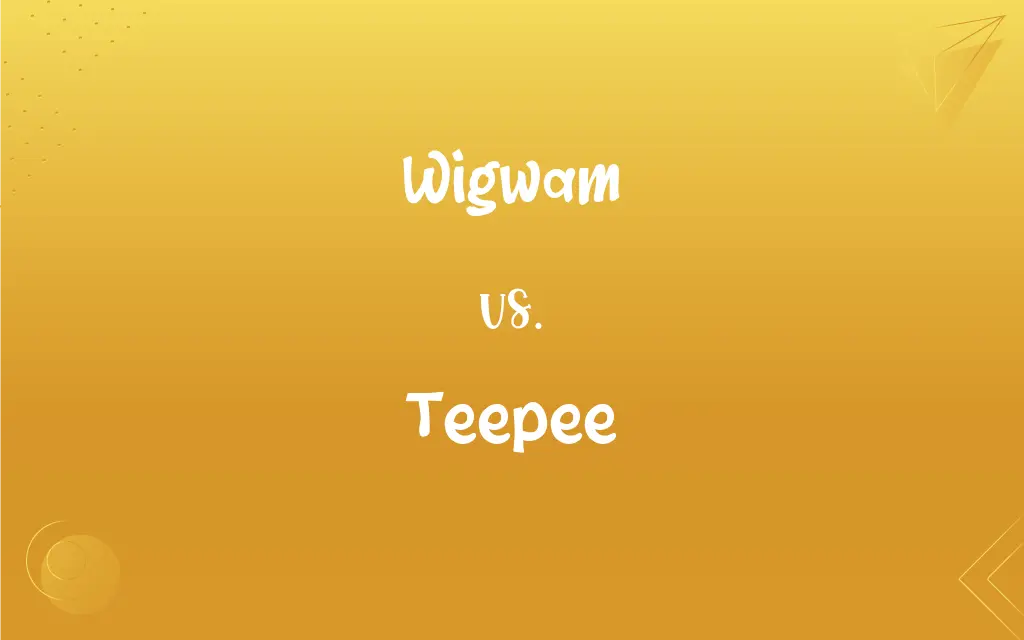Wigwam vs. Teepee: What's the Difference?
Edited by Aimie Carlson || By Harlon Moss || Published on February 22, 2024
A wigwam is a dome-shaped, permanent shelter made of wooden frames covered with bark or hides, while a teepee is a conical, portable tent made of long poles covered with animal skins or canvas, used by nomadic Plains Native American tribes.

Key Differences
Wigwams are semi-permanent structures traditionally used by some Native American tribes in the Eastern United States. They have a dome-like shape and are constructed with a frame of wooden poles, covered with woven mats or bark. Teepees, on the other hand, were primarily used by nomadic tribes of the Great Plains. Their cone-shaped structure, made of long poles and animal skins, allowed for easy assembly and disassembly.
The design of a wigwam makes it more suitable for stationary lifestyles. Its dome shape provides durability and stability, making it suitable for varied climates, but it's not easily transportable. Teepees were designed to be portable, catering to the nomadic lifestyle of the Plains tribes who followed buffalo herds. Their design allows them to be quickly dismantled and carried.
In a wigwam, the frame is covered with materials like bark, hides, or woven mats, providing insulation and protection from the elements. This makes them relatively warm and suitable for year-round living. Teepees, traditionally covered with buffalo hides and later with canvas, were also effective in different weather conditions, particularly adept at handling strong winds.
Wigwams typically have a small opening for a door and a hole at the top for smoke ventilation, as fires could be built inside. They are less uniform in size and shape, often reflecting the materials available in a particular region. Teepees also have a smoke hole at the top and a flap door, but their shape is more uniform, characterized by the conical structure that tapers to a point.
The construction of wigwams represents a variety of tribes, mostly in the northeastern parts of North America. They reflect a lifestyle that involved hunting, fishing, and small-scale agriculture. The teepee, synonymous with the Plains tribes like the Lakota, Sioux, and Blackfoot, symbolizes a culture deeply intertwined with the vast grasslands and the buffalo.
ADVERTISEMENT
Comparison Chart
Shape
Dome-shaped
Conical
Material
Wooden frames covered with bark or hides
Long poles covered with animal skins or canvas
Portability
Semi-permanent, not easily moved
Portable, designed for easy assembly and disassembly
Cultural Use
Used by tribes in the Eastern U.S., for stationary lifestyle
Used by nomadic Plains tribes, associated with buffalo hunting
Climate Adaptation
Suitable for varied climates, more insulated
Effective in windy conditions, adaptable to different weather
ADVERTISEMENT
Wigwam and Teepee Definitions
Wigwam
A native American dwelling, characteristic of tribes in the Eastern U.S.
Historical sites often feature reconstructed wigwams to illustrate tribal life.
Teepee
A dwelling made for easy assembly and disassembly by Plains tribes.
Nomadic tribes would quickly dismantle their teepees when it was time to move.
Wigwam
An indigenous shelter designed for small family groups.
Each wigwam housed a single family, providing them with warmth and security.
Teepee
A shelter made from animal skins or canvas, supported by long poles.
The teepee stood tall on the plains, its canvas flapping in the wind.
Wigwam
A dome-shaped, semi-permanent dwelling used by some Native American tribes.
The family lived in a wigwam near the riverbank, covered with birch bark.
Teepee
An emblem of the nomadic lifestyle of the Great Plains Native Americans.
Teepees symbolize the mobile, buffalo-hunting culture of the Plains tribes.
Wigwam
A traditional shelter made with a wooden frame and natural materials.
We learned how to construct a wigwam using wooden poles and woven mats.
Teepee
A tent-like structure adapted to the varying weather conditions of the Plains.
The teepee’s design allowed it to withstand the strong winds common in the Plains.
Wigwam
A symbol of Native American culture, representing a settled lifestyle.
Wigwams reflect the agricultural and hunting practices of the tribes that built them.
Teepee
A portable, conical tent traditionally used by nomadic Native American tribes.
The teepee was skillfully constructed with poles and buffalo hides.
Wigwam
A Native American dwelling commonly having an arched or conical framework overlaid with bark, hides, or mats.
Teepee
Variant of tepee.
Wigwam
A dwelling having an arched framework overlaid with bark, hides, or mats, used by Native Americans in the northeastern United States.
Teepee
A cone-shaped tent traditionally used by many native peoples of the Great Plains of North America.
Wigwam
Any more or less similar dwelling used by indigenous people in other parts of the world.
Teepee
A conical formation of small flammable sticks leaning on each other, in roughly the shape of an Indian teepee, built over smaller tinder such as cotton or leaves.
Wigwam
(transitive) To dry (flax or straw) by standing it outside in the shape of a wigwam.
Teepee
Alternative form of TP
Wigwam
An Indian cabin or hut, usually of a conical form, and made of a framework of poles covered with hides, bark, or mats; - called also tepee.
Very spacious was the wigwam,Made of deerskin dressed and whitened,With the gods of the DacotahsDrawn and painted on its curtains.
Teepee
A native American tent; usually of conical shape
Wigwam
A native American lodge frequently having an oval shape and covered with bark or hides
FAQs
What is a Teepee?
A conical, portable tent used by nomadic Plains Native American tribes.
What is a Wigwam?
A dome-shaped, semi-permanent dwelling used by Eastern Native American tribes.
How were Wigwams constructed?
Using a wooden frame covered with bark, hides, or woven mats.
What materials were used for Teepees?
Traditionally animal skins, and later canvas, stretched over long poles.
What was the primary use of a Teepee?
As a portable home for nomadic tribes following game across the Plains.
Did Teepees have smoke holes?
Yes, teepees had a smoke hole at the top with flaps to control airflow.
What was the primary use of a Wigwam?
As a semi-permanent dwelling for families in a settled community.
What was the social significance of Teepees?
Symbolic of the mobile lifestyle of Plains tribes and their connection to the buffalo.
Were Wigwams used across all Native American cultures?
Primarily used by tribes in the northeastern and midwestern U.S.
How did the climate influence the design of Wigwams?
Designed to be insulated and weather-resistant, suitable for varied climates.
How long would it take to construct a Wigwam?
Construction could take several days, depending on size and materials.
Were Teepees used across all Native American cultures?
Mainly used by the nomadic tribes of the Great Plains.
Are Wigwams and Teepees still used today?
They are mainly used for educational, ceremonial purposes, and cultural reenactments.
How did the climate influence the design of Teepees?
Made to be easily transportable and resilient against winds and different weather.
What was the social significance of Wigwams?
They represented a stable, community-oriented lifestyle.
How many people could live in a Wigwam?
Generally housed a single family, with size varying based on the tribe.
Do Wigwams and Teepees have cultural significance today?
Yes, they are important cultural symbols and are respected representations of indigenous heritage.
Did Wigwams have smoke holes?
Yes, they had a hole at the top for smoke to escape from indoor fires.
How long would it take to set up a Teepee?
A teepee could be set up or taken down relatively quickly, often in under an hour.
How many people could live in a Teepee?
Sized for individual families, accommodating around 6 to 10 people.
About Author
Written by
Harlon MossHarlon is a seasoned quality moderator and accomplished content writer for Difference Wiki. An alumnus of the prestigious University of California, he earned his degree in Computer Science. Leveraging his academic background, Harlon brings a meticulous and informed perspective to his work, ensuring content accuracy and excellence.
Edited by
Aimie CarlsonAimie Carlson, holding a master's degree in English literature, is a fervent English language enthusiast. She lends her writing talents to Difference Wiki, a prominent website that specializes in comparisons, offering readers insightful analyses that both captivate and inform.































































